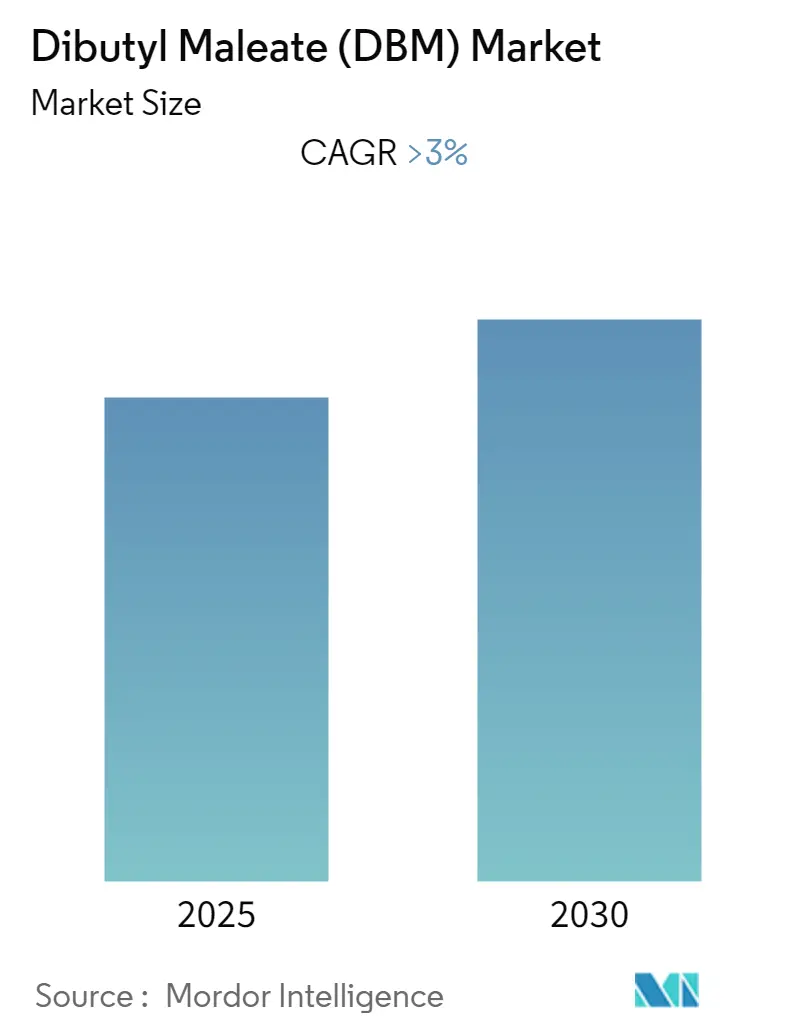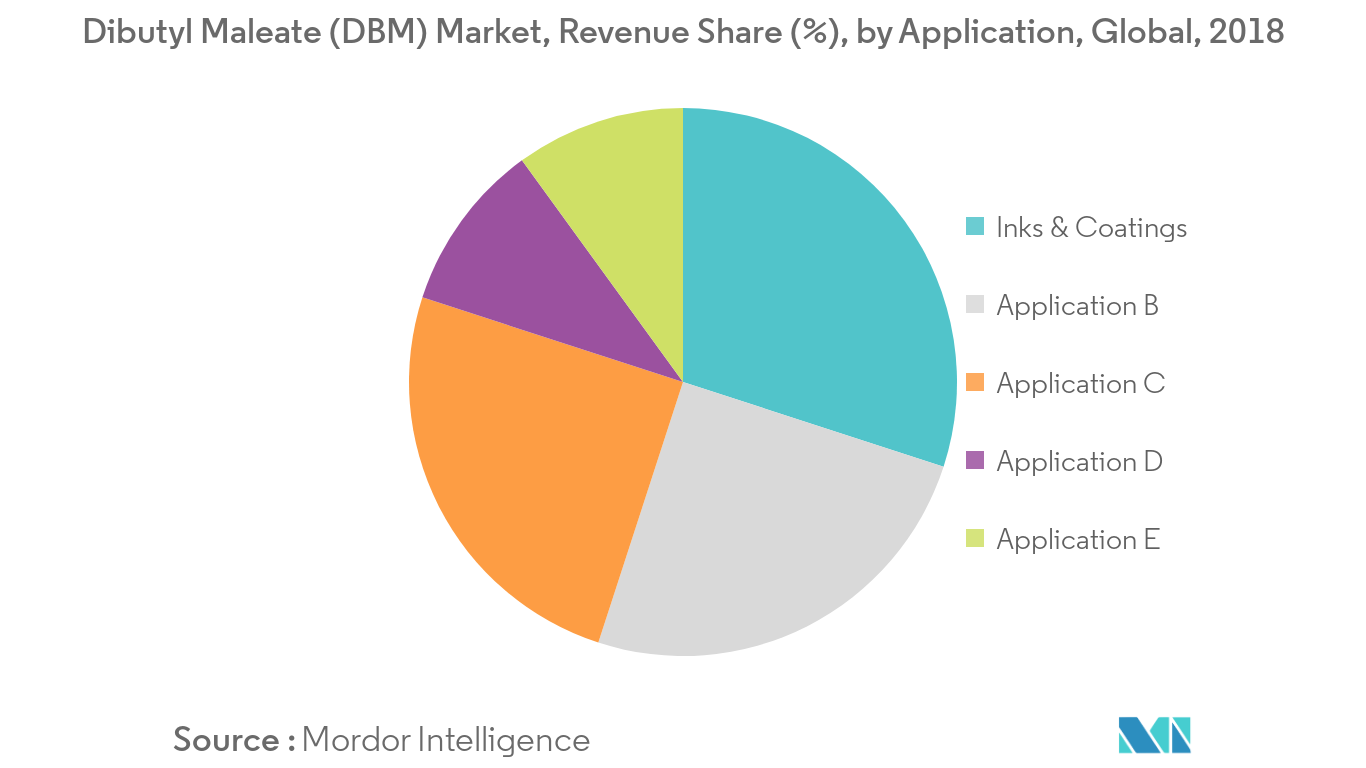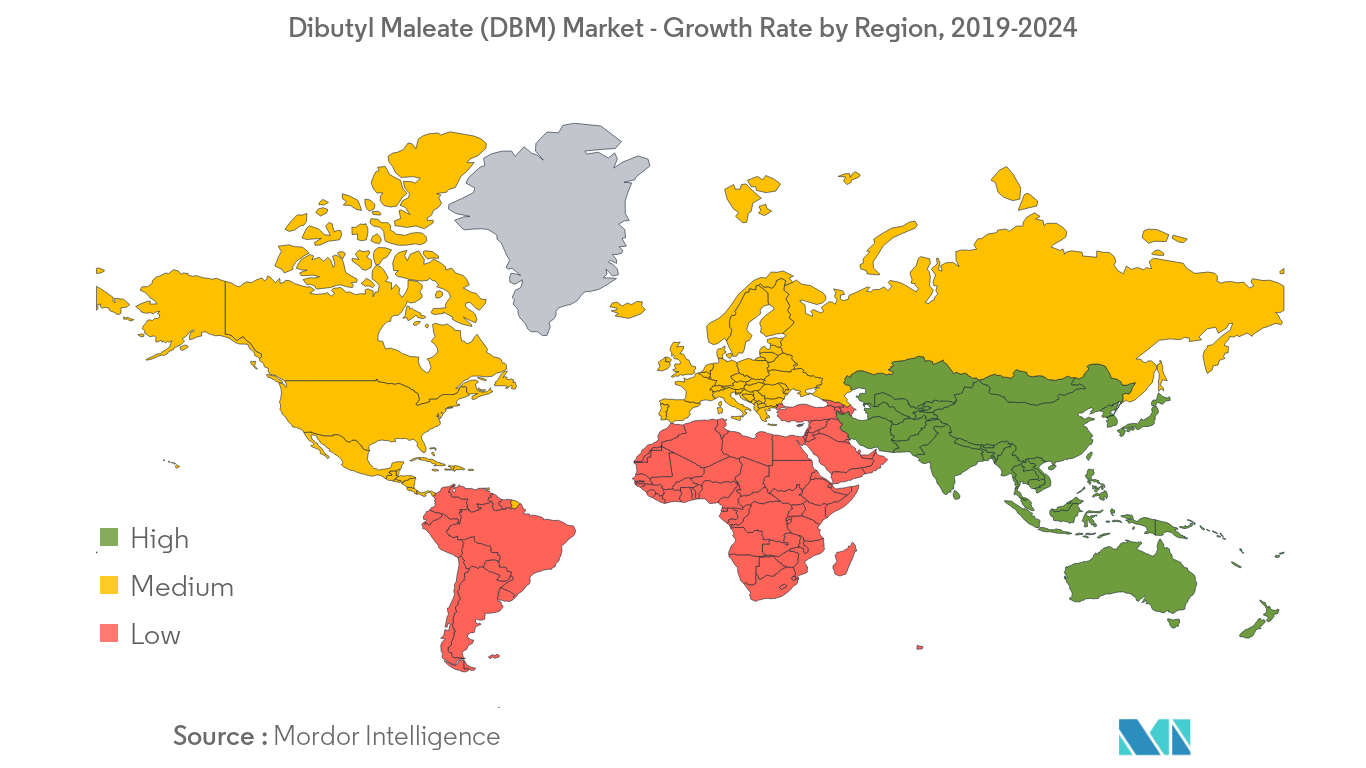
Dibutyl Maleate (DBM) Market Analysis
The Dibutyl Maleate Market is expected to register a CAGR of greater than 3% during the forecast period.
- The major factors driving the market studied include growing paints and coatings industry in Asia-Pacific.
- Asia-Pacific region is expected to dominate the global market during the forecast period.
- Inks & Coatings application do dominate the market during the forecast period.
Dibutyl Maleate (DBM) Market Trends
Increasing Demand for Inks & Coatings Application
- Dibutyl Maleate is also called as Maleic Acid or Dibutyl ester is a colorless liquid with an ester-like odor.
- It is used as an intermediate for the production of inks and coatings application.
- It is used in the manufacturing of paints to give it high flexibility, stability to water and ultra-violate light, besides a higher adherence.
- Growing construction activities in developing countries has been boosting the demand for paints and coatings in recent times.
- This increasing demand for coatings is expected to boost the demand for Dibutyl Maleate in coatings applications in coming years.

China to Dominate the Demand in Asia-Pacific Region
- The demand for Dibutyl Maleate in China is expected to rise at a great pace due to the increase in demand in various application such as coatings, plasticizers, adhesives among others.
- Asia-Pacific region is the largest producer and consumer of paints & coatings across the globe. The region is home for global manufacturers like Nippon Paints, Kansai Paints, Asian Paints, etc.
- China produces more than half of the Asia-Pacific coatings, and is home to more than 10,000 paint companies, among which local producers occupies more than half of the domestic paint market share.
- The country also one of the top producers of adhesives globally. The government is also encouraging foreign countries to invest in the country.
- Furthermore, countries such as India and Japan have also been contributing to the growth of the market studied. This is expected to further drive the demand for dibutyl maleate market over the forecast period.

Dibutyl Maleate (DBM) Industry Overview
The global Dibutyl Maleate market is partially consolidated in nature. Some of the major players of the market studied include, Celanese Corporation, Sigma-Aldrich, Inc., Polynt, Nayakem, and WeiFang Tuoshi Chemical Co., Ltd, among others.
Dibutyl Maleate (DBM) Market Leaders
-
Celanese Corporation
-
Sigma-Aldrich, Inc.
-
Nayakem
-
WeiFang Tuoshi Chemical Co., Ltd
-
Polynt
- *Disclaimer: Major Players sorted in no particular order
.png)
Dibutyl Maleate (DBM) Industry Segmentation
The global Dibutyl Maleate market includes:
| Application | Inks & Coatings | ||
| Chemical Intermediate | |||
| Plasticizers | |||
| Adhesives | |||
| Others (Synthetic Lubricants etc.) | |||
| Geography | Asia-Pacific | China | |
| India | |||
| Japan | |||
| South Korea | |||
| Rest of Asia-Pacific | |||
| North America | United States | ||
| Canada | |||
| Mexico | |||
| Europe | Germany | ||
| United Kingdom | |||
| Italy | |||
| France | |||
| Rest of Europe | |||
| Rest of the World | |||
Dibutyl Maleate (DBM) Market Research FAQs
What is the current Dibutyl Maleate (DBM) Market size?
The Dibutyl Maleate (DBM) Market is projected to register a CAGR of greater than 3% during the forecast period (2025-2030)
Who are the key players in Dibutyl Maleate (DBM) Market?
Celanese Corporation, Sigma-Aldrich, Inc., Nayakem, WeiFang Tuoshi Chemical Co., Ltd and Polynt are the major companies operating in the Dibutyl Maleate (DBM) Market.
Which is the fastest growing region in Dibutyl Maleate (DBM) Market?
Asia Pacific is estimated to grow at the highest CAGR over the forecast period (2025-2030).
Which region has the biggest share in Dibutyl Maleate (DBM) Market?
In 2025, the Asia Pacific accounts for the largest market share in Dibutyl Maleate (DBM) Market.
What years does this Dibutyl Maleate (DBM) Market cover?
The report covers the Dibutyl Maleate (DBM) Market historical market size for years: 2019, 2020, 2021, 2022, 2023 and 2024. The report also forecasts the Dibutyl Maleate (DBM) Market size for years: 2025, 2026, 2027, 2028, 2029 and 2030.
Our Best Selling Reports
Dibutyl Maleate (DBM) Industry Report
Statistics for the 2025 Dibutyl Maleate (DBM) market share, size and revenue growth rate, created by Mordor Intelligence™ Industry Reports. Dibutyl Maleate (DBM) analysis includes a market forecast outlook for 2025 to 2030 and historical overview. Get a sample of this industry analysis as a free report PDF download.


